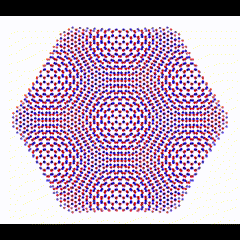| Oct 30, 2023 |
Researchers find analytical solutions for 1D channels in twisted bilayer graphene
(Nanowerk News) The work methodology in a theoretical group often implies discussions in front of the data to elucidate what is the story the nature is trying to tell us. One day, an interesting revelation took place at IMDEA Nanociencia institute in Madrid.
|
|
Dr. Pierre Pantaleón, researcher at the Group of Theoretical Modelling at IMDEA Nanociencia, was discussing with Prof. Paco Guinea – the leader of the Group – about strained bilayer graphene, it is, two layers of graphene piled on top of each other and slightly stretched out by a small force.
|
|
Pierre, a meticulous researcher with a penchant for visual aids, was showing the group his animated visualization of strained graphene when Paco noticed an anomaly that had escaped everyone else’s scrutiny. As it turns out, when bilayer graphene goes under strain, its Brillouin zone (the unit cell in the momentum space) is distorting, and eventually, collapsing in one direction. This distortion at the collapsing point caused an error in Pierre's visualization programme suggesting the presence of some kind of singularity.
|
 |
| Moiré patterns. (Image: IMDEA)
|
|
In Physics, singularities, like the one the researchers were observing, demand careful consideration. They could indicate something may be amiss, shifting, or simply necessitating a closer examination. By that time, Dr. Andreas Sinner, a brilliant theoretical physicist currently working on Opole University on Poland, joined Paco’s research group and started looking together with Pierre on the origin of this singularity. It was the concurrent transformation in real space that truly captivated their attention: strained graphene gave rise to the emergence of almost perfect one-dimensional moiré patterns – one-dimensional channels – within the 2-dimensional material.
|
|
Previously, scientists had glimpsed such phenomena through microscopes and had regarded them as design errors such as dislocations or adhered materials. See for example the work of McEuen (Cornell Uni.), Mendoza (Rio de Janeiro Uni) or Zhu (Columbia Uni.). But behind what appeared to be artifacts were masked effects the researchers describe now. The research team at IMDEA Nanociencia confirms that this is a natural occurrence within hexagonal honeycomb lattices -like those of graphene- specifically taking place when two layers are stacked at a slight twist angle, and strain is applied.
|
|
The most significant contribution of the researchers lies in their discovery of analytical solutions for the critical strain required to generate these one-dimensional channels. Surprisingly, this solution is beautifully simple, relying on just two variables: the twist angle and the Poisson ratio—a material-specific constant. Their findings lead them to obtain a single mathematical formula to describe the phenomenon, and this formula gives us information on the physical origin.
|
 |
| Evolution of the energy landscape of twisted bilayer graphene as a function of the applied strain. Close to the critical strain the collapse of the Brillouin zone is appreciated. (© Physical Review Letters)
|
|
The physics described in their work, published in Physical Review Letters ("Strain-Induced Quasi-1D Channels in Twisted Moiré Lattices"), is not new, but the explanation of the phenomenon in such simple terms –single analytical expression- is elegant and unique. The findings open the door to engineering novel materials on surfaces capable of featuring these one-dimensional channels. Within these channels, electrons find themselves confined, in contrast to the free movement they exhibit in the standard 2D graphene landscape. Electrons within these channels exhibit a preferential direction of movement.
|
|
The implications of this discovery are vast, with potential applications extending to other materials, such as dichalcogenides, and can be extended to other geometric configurations as well.
|
|
The Group of Prof. Guinea is actively investigating the possibilities of graphene, in twisted and non-twisted bilayers, that includes the observation of superconductivity. A comprehensive review was published recently in Nature Reviews Physics ("Superconductivity and correlated phases in non-twisted bilayer and trilayer graphene").
|
|
This work is an output of the Theoretical Modelling Group at IMDEA Nanociencia.
|


